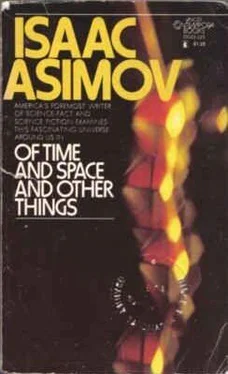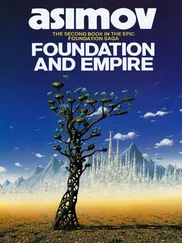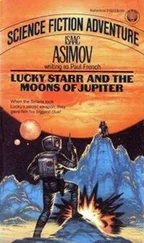Isaac Asimov - Of Time and Space and Other Things
Здесь есть возможность читать онлайн «Isaac Asimov - Of Time and Space and Other Things» весь текст электронной книги совершенно бесплатно (целиком полную версию без сокращений). В некоторых случаях можно слушать аудио, скачать через торрент в формате fb2 и присутствует краткое содержание. Год выпуска: 1972, ISBN: 1972, Издательство: Lancer Books, Жанр: Прочая научная литература, на английском языке. Описание произведения, (предисловие) а так же отзывы посетителей доступны на портале библиотеки ЛибКат.
- Название:Of Time and Space and Other Things
- Автор:
- Издательство:Lancer Books
- Жанр:
- Год:1972
- ISBN:ISBN: 0-447-33023-3
- Рейтинг книги:4 / 5. Голосов: 1
-
Избранное:Добавить в избранное
- Отзывы:
-
Ваша оценка:
- 80
- 1
- 2
- 3
- 4
- 5
Of Time and Space and Other Things: краткое содержание, описание и аннотация
Предлагаем к чтению аннотацию, описание, краткое содержание или предисловие (зависит от того, что написал сам автор книги «Of Time and Space and Other Things»). Если вы не нашли необходимую информацию о книге — напишите в комментариях, мы постараемся отыскать её.
Of Time and Space and Other Things — читать онлайн бесплатно полную книгу (весь текст) целиком
Ниже представлен текст книги, разбитый по страницам. Система сохранения места последней прочитанной страницы, позволяет с удобством читать онлайн бесплатно книгу «Of Time and Space and Other Things», без необходимости каждый раз заново искать на чём Вы остановились. Поставьте закладку, и сможете в любой момент перейти на страницу, на которой закончили чтение.
Интервал:
Закладка:
Now why is a Gas a Gas?
I can start by saying that every substance is made up of atoms, or of closely knit groups of atoms, said groups being called molecules. There are attractive forces between atoms or molecules which make them "sticky" and tend to hold them together. Heat, however, lends these atoms or molecules a certain kinetic energy (energy of motion) which tends to drive them apart,.since each atom or mole cule has its own idea of where it wants to go. [I enjoy sin]
The attractive forces among a given set of atoms or molecules are relatively constant, but the kinetic energy varies with the temperature. Therefore, if the temperature is raised high enough, any group of atoms or molecules will fly apart and the material becomes a gas. At tempera tures over 60000 C. all known substances are gases.
Of course, there are only a, few exceptional substances with interatomic or intermolecular forces so strong that it takes 6000' C. to overcome them. Some substances, on the other hand, have such weak intermolecular attractive forces that the warmth of a summer day supplies enough kinetic energy to convert them to gas (the common anes thetic, ether, is an example).
Still others have intermolecular attractive forces so much weaker still that there is enough heat at a tempera ture of -I 00' C. to keep them gases, and it is these that are the Gases I am talking about.
The intermolecular or interatomic forces arise out of the distribution of electrons within the atoms or molecules.
The electrons are distributed among various "electron shells," according to a system we can,accept without de tailed explanation. For instance, the aluminum atom con tains 13 electrons, which are distributed as follows: 2 in the innermost shell, 8 in the next shell, and 3 in the next shell. We can therefore signify the electron distribution in the aluminum atom as 2,8,3.
The most stable and symmetrical distribution of the electrons among the electron shells is that distribution in which the outermost shell holds either all the electrons it can hold, or 8 electrons-whichever is less. The innermost electron shell can hold only 2, the next can hold 8, and each of the rest can hold more than 8. Except for the situ ation where only the innermost shell contains electrons, * No, I am not implying that atoms know what they are doing and have consciousness. This is just my teleological way of talk ing. Teleology is forbidden in scientific'articies, 1-ut it s'o happens then, the stable situation consists of 8 electrons in the outermost shell.
There are exactly six elements known in which this situ ation of maximum stability exists:
Electron Electron Element Symbol Distribution Total helium He 2 2 neon Ne 2,8 10 argon Ar 2,8,8 is krypton Kr 2,8,18,8 36 xenon Xe 2,8,18,18,8 54 radon Rn 2,8,18,32,18,8 86
Other atoms without this fortunate electronic distribu tion are forced to attempt to achieve it by grabbing addi tional electrons, or getting rid of some they already pos sess, or sharing electrons. In so doing, they undergo chem ical reactions. The atoms of the six elements listed above, however, need do nothing of this sort and are sufficient unto themselves. They have no need to shift electrons in any way and that means they take part in no chemical reactions and are inert. (At least, this is what I would have said prior to 1962.)
The atoms of the inert gas family listed above are so self-sufficient, in fact, that the atoms even ignore one another. There is little interatomic attraction, so that all are gases at room temperature and all but radon are Gases.
To be sure, there is some interatomic attraction (for no atoms or molecules exist among which there is no attrac tion at all). If one lowers the temperature sufficiently, a point is reached where the attractive forces become dom inant over the disruptive effect of kinetic energy, and every single one of the inert gases will, eventually, become an inert liquid.
What about other elements? As I said, these have atoms with electron distributions of less than maximum stability and each has a tendency to alter that distribution in the direction of stability. For instance, the sodium atom (Na) has a distribution of 2,8, I. If it could get rid of the outer most electron, what would be left would have the stable 2 8 configuration of neon. Again, the chlorine atom (CI) b@s a distribution of 2,8,7. If it could gain an electron, it would have the 2,8,8 distribution of argon.
Consequently, if a sodium atom encounters a chlorine atom, the transfer of an electron from the sodium atom to the chlorine atom satisfies both. However, the loss of a negatively charged electron leaves the sodium atom with a deficiency of negative charge or, which is the same thing, an excess of positive charge. It becomes a positively charged sodium ion (Na+). The chlorine atom, on the other band, gaining an electron, gains an excess of nega tive charge and becomes a negatively charged chloride ion ["chlorine ion" as a convention of chemi amp;al nomenclature we might just as well accept with a weary sigh. Anyway, the "d" is not a typographical error] (CI-).
Opposite charges attract, so the sodium ion attracts all the chloride ions within reach and vice versa. These strong attractions cannot be overcome by the kinetic energy in duced at ordinary temperatures, and so the ions hold to gether firmly enough for "sodium chloride" (common salt) to be a solid. It does not become a gas, in fact, until a temperature of 1413' C. is reached. .Next, consider the carbon atom (C). Its electron dis tribution is 2,4. If it lost 4 electrons, it would gain the 2 helium configuration; if it gained 4 electrons, it would gain the 2,8 neon configuration. Losing or gaining that many electrons is not easy,_so the carbon atom shares electrons instead. It can, for instance, contribute one of its electrons to a "shared pool" of two electrons, a pool to which a neighboring carbon atom also contributes an elec tron. With its second electron it can form another shared pool with a second neighbor, and with its third and fourth, two more pools with two more neighbors. Each neighbor * The charged chlorine atom is called "chloride ion" and not ran set up additional pools with other neighbors. In this way, each carbon atom is surrounded by four other carbon atoms.
These shared electrons fit into the outermost electron shells of each carbon atom that contributes. Each carbon atom has 4 electrons of its own in that outermost shell and 4 electrons contributed (one apiece) by four neighbors.
Now, each carbon atom has the 2,8 configuration of neon, but only at the price of remaining close to its neighbors.
The result is a strong interatomic attraction, even though electrical charge is not involved. Carbon is a solid'and is not a gas until a temperature of 42000 C. is reached.
The atoms of metallic elements also stick together ,strongly, for similar reasons, so that tungsten, for instance, is not a gas until a temperature of 59000 C. is reached.
We cannot, then, expect to have a Gas when atoms achieve stable electron distribution by transferring elec trons in such a manner as to gain an electric charge; or by sharing electrons in so complicated a fashion that vast numbers of atoms stick together in one piece.
What we need is something intermediate. We need a situation where atoms achieve stability by sharing electrons (so that no electric charge arises) but where the total number of atoms involved in the sharing is very small so that only small molecules result. Within the molecules, attractive forces may be large, and the molecules may not be shaken apart without extreme temperature. The attrac tive forces between one molecule and its neighbor, how ever, may be smafl-and that will do.
Let's consider the hydrogen atom, for instance. It has but a single electron. Two hydrogen atoms can each con tribute its single electron to form a shared pool. As long as they stay together, each can count both electrons in its outermost shell and each will have the stable helium configuration. Furthermore, neither hydrogen atom will have any electrons left to form pools with other neighbors, hence the molecule will end there. Hydrogen gas will con sist of two-atom molecules (H2) The attractive force between the atoms in the molecule is large, and it takes temperatures of more than 20001 C. to shake even a small fraction of the hydrogen molecules into single atoms. There will, however, be only weak at tractions among separate hydrogen molecules, each of which, under the new arrangement, will have reached a satisfactory pitch of self-sufficiency. Hydrogen, therefore, will be a Gas not made up of separate atoms as is the case with the inert gases, but of two-atom molecules.
Читать дальшеИнтервал:
Закладка:
Похожие книги на «Of Time and Space and Other Things»
Представляем Вашему вниманию похожие книги на «Of Time and Space and Other Things» списком для выбора. Мы отобрали схожую по названию и смыслу литературу в надежде предоставить читателям больше вариантов отыскать новые, интересные, ещё непрочитанные произведения.
Обсуждение, отзывы о книге «Of Time and Space and Other Things» и просто собственные мнения читателей. Оставьте ваши комментарии, напишите, что Вы думаете о произведении, его смысле или главных героях. Укажите что конкретно понравилось, а что нет, и почему Вы так считаете.












